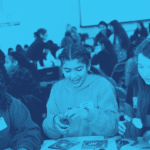Spend five minutes reading #BigTech or #Gentrification posts on Twitter or Instagram and you’ll realize how constant, and increasingly negative, discussions about Silicon Valley’s innovation economy have become. These posts blame the Bay Area’s biggest employers for singlehandedly creating the environment that leads to the displacement of people of color from their communities, shine a light on the lack of Black and Latinx STEM employees, and paint a grim portrait of “tech bro” cultures that alienate nontraditional hires.
Rather than shying away from these challenges, our network of Leadership Group executives is increasingly acknowledging and addressing systems of racial inequity in Silicon Valley with bold initiatives and company-wide system changes. And forward looking companies have found that onboarding diverse talent (women, people of color, veterans) effectively increases all employee skill sets and knowledge bases, and strengthens community relationships. These companies are focused on diversifying their local STEM pipeline to learn from, and employ, the rich cultural, racial, and gender diversity of the Bay Area and Silicon Valley.
And there are studies that support the need for addressing these issues. In 2018, Pew Research found that STEM companies in Silicon Valley continue to underrepresent and underpay Black and Latinx workers, who make up only 16% of the STEM workforce despite years of well-intentioned initiatives to address this issue. And in 2019, Pew found that 62% of Black and 42% of Latinx and Asian STEM workers report racial discrimination in the workforce and hiring, compared to only 13% of white workers.
One of the ways the Leadership Group addresses this focus is our Community College to Career Initiative, or CC2C for short. CC2C facilitates training and hiring relationships between all 19 Silicon Valley community colleges and our member companies to expand economic opportunity and increase diversity in the STEM workforce.
Why the turn toward community colleges? With 350,000 students in Silicon Valley (77% of whom are students of color), and a state mandate to align curriculum with industry needs, community colleges are well-positioned to provide a robust pipeline of talented, diverse workers to fill immediate and long-term skill gaps. Key to this pipeline: employers who will strengthen their own local talent pool by advising colleges on curriculum and providing work-based learning opportunities to students.
On June 18, the Leadership Group held our third annual Community College to Career dinner at the City Club of San Francisco, bringing together executives representing 17 member companies and all 19 Silicon Valley community colleges. Our annual dinner is a keystone event for CC2C. We keep the gathering small to enable candid, face-to-face conversations that create high-level, cross-sector relationships. Our program centers on the concrete steps employers and colleges can take to strengthen both two-year degree training and the transfer rates for four-year STEM degrees–with an explicit focus on women and diverse students.
This year’s dinner was hosted by CC2C initiative champion Bill Nagel, Leadership Group board member and CEO and publisher of the San Francisco Chronicle. Nagel and representatives from Silicon Valley Bank and Steinberg Hart kicked off the dinner with tangible, replicable examples of their own engagement with CC2C — hosting interns, bringing students to their corporate campuses for career exposure, and facilitating student roundtables at their companies to acquaint their own HR teams with community college talent.
After these employers shared best practices, the CC2C team opened the conversation to the room, asking employers to describe their skills needs and college leaders their training programs. The night ended with a 30-minute strategic networking session, which allowed employers and colleges to discuss training partnerships that would equip students with specific, hirable skill sets.
Immediate takeaway: by the end of the dinner, all 17 member companies — most of whom had never recruited from community colleges — committed to exploring partnership opportunities with the colleges in the room. CC2C staff is now setting up meetings between these employer and college pairings in industries from construction to IT to journalism.
Broader takeaway: participating companies committed to systems change, to re-assessing the systems they use to recruit, hire and train their workforce, and to exploring innovative solutions.
At the Leadership Group, we believe in practicing what we preach and have been privileged to bring on local community college students as interns to great success. We are committed to allowing all qualified students an equitable opportunity for success and will continue to change our own onboarding practices to reflect this. By partnering with our local community colleges, we, and our member companies, can recruit, train, and retain the best and brightest, and ensure more Californians have a place in the innovation economy. Contact David Palter today at dpalter@svlg.org to get involved.
Audrey Momoh, Policy Fellow, Leadership for Educational Equity & David Palter, Director of Higher Education and Workforce Development | July 22, 2019






